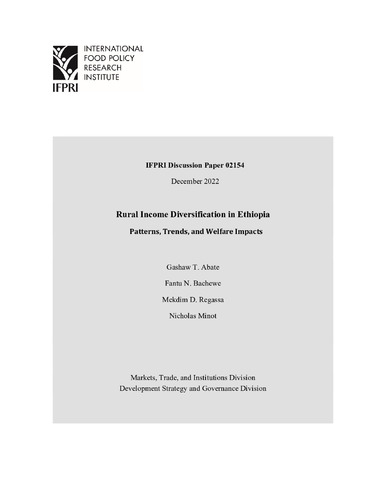Rural income diversification in Ethiopia: Patterns, trends, and welfare impacts
Abstract
Increased diversification of rural households into the rural non-farm economy is an important driver of economic growth and structural transformation in countries like Ethiopia where the vast majority of people live in rural areas and are largely dependent on seasonal agriculture. Some of the benefits of diversification include efficient utilization of asset endowments (e.g., labor during dry season) and reduction of risks. In this study we explore the: (i) patterns and trends of diversification, (ii) drivers of diversification including the association between rainfall risk/shocks and diversification, and (iii) welfare effects of diversification during the recent decade using three rounds of representative household data from the four main regions of Ethiopia. We used Cragg’s double-hurdle model, a method that considers the two-step decision making process in diversification (i.e., participation and extent of participation), to identify the determinants of diversification and a fixed-effect and instrumental variable (IV) approaches to understand the links between diversification and household welfare. The descriptive results show that rural households generally adopt a livelihood strategy dominated by farming and that the level of diversification has been stagnant over the period of analysis considered. More importantly, the vast majority of households continue to draw a substantial share of their income from crop production, followed by livestock. The income from non-farm activities accounts only between 17 percent and 23 percent of the total income. The econometrics results show that diversification is positively associated with credit access, membership in social insurance, ownership of mobile phone, relative measure of household wealth, and population density. Conversely, access to relatively large, fertile, and irrigable land discourages diversification into non-farm activities. The analysis on the association between rainfall risks and diversification indicates that rural households use income diversification both as risk mitigation and shock coping strategy. The results on the link between income diversification and household welfare indicate a positive association between diversification and household total consumption expenditure, dietary diversity score, and housing/roof quality. In sum, the results imply the need for a deliberate effort to expand the non-farm economy so as to tap its full potential for employment generation, income growth, and welfare improvements. A starting point could be for agricultural and rural development policies and investments to go beyond promotion of cereal crop production and facilitate participation in high value crop, livestock, aquaculture production. Incentivizing investments in value addition activities that can create and enrich upward and downward linkages in the midstream segment of agricultural value chains is another potential avenue to boost rural non-farm economy.

